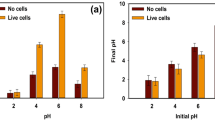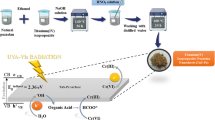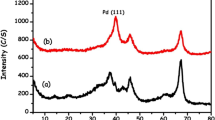Abstract
In this study, we report the synthesis of indium tin oxide (ITO) decorated Pt–Pd nanoparticle by a simple and facile liquid phase deposition protocol and their application as a heterogeneous catalyst for the reduction of toxic hexavalent chromium. Different characterization techniques were used to confirm the synthesized nanoparticles are honeycomb-like structure. The average size of nanoparticles was found to be 2–5 nm and uniformly distributed over ITO surface. During this study, the parameter was optimized such as the effect of different reducing agent and their concentration, effect of microwaves radiation and dose of nanoparticles. It was observed that the kinetic mechanism was best describes by the pseudo-first order. The synthesized Pt–Pd nanoparticles were successfully applied as an excellent heterogeneous catalyst for reduction of Cr(VI) to Cr(III) in water. The synthesized nanocatalyst was good in term of fast kinetic, high catalytic efficiency, excellent recyclability, and analytical applicability for fast and efficient reduction of toxic hexavalent chromium as compared to conventional methods of nanocatalysts.
Graphic Abstract
Schematic illustration of hexavalent chromium reduction











Similar content being viewed by others
References
Huang Y, Ma H, Wang S, Shen M, Guo R, Cao X, Zhu M, Shi X (2012) Efficient catalytic reduction of hexavalent chromium using palladium nanoparticle-immobilized electrospun polymer nanofibers. ACS Appl Mater Interfaces 4:3054–3061
Kumar A, Balouch A, Pathan AA, Abdullah, Jagirani MS, Mahar AM, Rajput M-U-H (2019) Novel chromium imprinted polymer: synthesis, characterization and analytical applicability for the selective remediation of Cr(VI) from an aqueous system. Int J Environ Anal Chem. https://doi.org/10.1080/03067319.2019.1599876
Bhowmik K, Mukherjee A, Mishra MK, De G (2014) Stable Ni nanoparticle–reduced graphene oxide composites for the reduction of highly toxic aqueous Cr(VI) at room temperature. Langmuir 30:3209–3216
Krishnani KK, Srinives S, Mohapatra B, Boddu VM, Hao J, Meng X, Mulchandani A (2013) Hexavalent chromium removal mechanism using conducting polymers. J Hazard Mater 252:99–106
Wu J-H, Shao F-Q, Han S-Y, Bai S, Feng J-J, Li Z, Wang A-J (2019) Shape-controlled synthesis of well-dispersed platinum nanocubes supported on graphitic carbon nitride as advanced visible-light-driven catalyst for efficient photoreduction of hexavalent chromium. J Colloid Interface Sci 535:41–49
Kumar A, Balouch A, Pathan AA, Mahar AM, Abdullah MS, Jagirani FA, Mustafai M, Zubair B Laghari, Panah P (2017) Remediation techniques applied for aqueous system contaminated by toxic Chromium and Nickel ion. Geol Ecol Landsc 1:143–153
Wei L-L, Gu R, Lee J-M (2015) Highly efficient reduction of hexavalent chromium on amino-functionalized palladium nanowires. Appl Catal B 176:325–330
Omole MA, Okello VA, Lee V, Zhou L, Sadik OA, Umbach C, Sammakia B (2011) Catalytic reduction of hexavalent chromium using flexible nanostructured poly (amic acids). ACS Catal 1:139–146
Park D, Yun Y-S, Park JM (2004) Reduction of hexavalent chromium with the brown seaweed Ecklonia biomass. Environ Sci Technol 38:4860–4864
Patterson RR, Fendorf S, Fendorf M (1997) Reduction of hexavalent chromium by amorphous iron sulfide. Environ Sci Technol 31:2039–2044
Wu J-H, Shao F-Q, Luo X-Q, Xu H-J, Wang A-J (2019) Pd nanocones supported on g-C3N4: an efficient photocatalyst for boosting catalytic reduction of hexavalent chromium under visible-light irradiation. Appl Surf Sci 471:935–942
Hu L-Y, Chen L-X, Liu M-T, Wang A-J, Wu L-J, Feng J-J (2017) Theophylline-assisted, eco-friendly synthesis of PtAu nanospheres at reduced graphene oxide with enhanced catalytic activity towards Cr(VI) reduction. J Colloid Interface Sci 493:94–102
Ye S, Zeng G, Wu H, Zhang C, Dai J, Liang J, Yu J, Ren X, Yi H, Cheng M (2017) Biological technologies for the remediation of co-contaminated soil. Crit Rev Biotechnol 37:1062–1076
Ye S, Zeng G, Wu H, Zhang C, Liang J, Dai J, Liu Z, Xiong W, Wan J, Xu P (2017) Co-occurrence and interactions of pollutants, and their impacts on soil remediation—a review. Crit Rev Environ Sci Technol 47:1528–1553
Ye S, Zeng G, Wu H, Liang J, Zhang C, Dai J, Xiong W, Song B, Wu S, Yu J (2019) The effects of activated biochar addition on remediation efficiency of co-composting with contaminated wetland soil. Resour Conserv Recycl 140:278–285
Yang S, Luo X (2014) Mesoporous nano/micro noble metal particles: synthesis and applications. Nanoscale 6:4438–4457
Zhang H, Jin M, Xia Y (2012) Noble-metal nanocrystals with concave surfaces: synthesis and applications. Angew Chem Int Ed 51:7656–7673
Quan Z, Wang Y, Fang J (2012) High-index faceted noble metal nanocrystals. Acc Chem Res 46:191–202
Cheong S, Watt JD, Tilley RD (2010) Shape control of platinum and palladium nanoparticles for catalysis. Nanoscale 2:2045–2053
Xiong Y, Xia Y (2007) Shape-controlled synthesis of metal nanostructures: the case of palladium. Adv Mater 19:3385–3391
Chen J, Lim B, Lee EP, Xia Y (2009) Shape-controlled synthesis of platinum nanocrystals for catalytic and electrocatalytic applications. Nano Today 4:81–95
Gong M, Fu G, Chen Y, Tang Y, Lu T (2014) Autocatalysis and selective oxidative etching induced synthesis of platinum–copper bimetallic alloy nanodendrites electrocatalysts. ACS Appl Mater Interfaces 6:7301–7308
Cunci L, Velez CA, Perez I, Suleiman A, Larios E, José-Yacamán M, Watkins JJ, Cabrera CR (2014) Platinum electrodeposition at unsupported electrochemically reduced nanographene oxide for enhanced ammonia oxidation. ACS Appl Mater Interfaces 6:2137–2145
Nguyen T-T, Pan C-J, Liu J-Y, Chou H-L, Rick J, Su W-N, Hwang B-J (2014) Functional palladium tetrapod core of heterogeneous palladium–platinum nanodendrites for enhanced oxygen reduction reaction. J Power Sources 251:393–401
Wang Q, Wang Y, Guo P, Li Q, Ding R, Wang B, Li H, Liu J, Zhao X (2014) Formic acid-assisted synthesis of palladium nanocrystals and their electrocatalytic properties. Langmuir 30:440–446
Chen M, Wu B, Yang J, Zheng N (2012) Small adsorbate-assisted shape control of Pd and Pt nanocrystals. Adv Mater 24:862–879
Hu B, Ding K, Wu T, Zhou X, Fan H, Jiang T, Wang Q, Han B (2010) Shape controlled synthesis of palladium nanocrystals by combination of oleylamine and alkylammonium alkylcarbamate and their catalytic activity. Chem Commun 46:8552–8554
Wang Y, Xie S, Liu J, Park J, Huang CZ, Xia Y (2013) Shape-controlled synthesis of palladium nanocrystals: a mechanistic understanding of the evolution from octahedrons to tetrahedrons. Nano Lett 13:2276–2281
Li D-N, Shao F-Q, Feng J-J, Wei J, Zhang Q-L, Wang A-J (2018) Uniform Pt@ Pd nanocrystals supported on N-doped reduced graphene oxide as catalysts for effective reduction of highly toxic chromium (VI). Mater Chem Phys 205:64–71
Zhao R, Fu G, Zhou T, Chen Y, Zhu X, Tang Y, Lu T (2014) Multi-generation overgrowth induced synthesis of three-dimensional highly branched palladium tetrapods and their electrocatalytic activity for formic acid oxidation. Nanoscale 6:2776–2781
Chu Y-T, Chanda K, Lin P-H, Huang MH (2012) Aqueous phase synthesis of palladium tripod nanostructures for Sonogashira coupling reactions. Langmuir 28:11258–11264
Zhu H, Li G, Chi Q, Zhao Y, Liu H, Li J, Huang T (2012) Controlled synthesis of tetrapod/Mitsubishi-like palladium nanocrystals. CrystEngComm 14:1531–1533
Dai Y, Mu X, Tan Y, Lin K, Yang Z, Zheng N, Fu G (2012) Carbon monoxide-assisted synthesis of single-crystalline Pd tetrapod nanocrystals through hydride formation. J Am Chem Soc 134:7073–7080
Zhu H, Li G, Lv X, Zhao Y, Huang T, Liu H, Li J (2014) Controlled synthesis of hierarchical tetrapod Pd nanocrystals and their enhanced electrocatalytic properties. RSC Adv 4:6535–6539
Watt J, Young N, Haigh S, Kirkland A, Tilley RD (2009) Synthesis and structural characterization of branched palladium nanostructures. Adv Mater 21:2288–2293
Shao F-Q, Feng J-J, Lin X-X, Jiang L-Y, Wang A-J (2017) Simple fabrication of AuPd@ Pd core-shell nanocrystals for effective catalytic reduction of hexavalent chromium. Appl Catal B 208:128–134
Balouch A, Umar A (2016) Heterogeneous catalytic degradation of nitro-aromatic compound using highly defect spongy surface palladium nanocatalyst. Nucleus 53:64–69
Omole MA, K’Owino IO, Sadik OA (2007) Palladium nanoparticles for catalytic reduction of Cr(VI) using formic acid. Appl Catal B 76:158–167
Dandapat A, Jana D, De G (2011) Pd nanoparticles supported mesoporous γ-Al2O3 film as a reusable catalyst for reduction of toxic CrVI to CrIII in aqueous solution. Appl Catal A 396:34–39
Fu G-T, Jiang X, Wu R, Wei S-H, Sun D-M, Tang Y-W, Lu T-H, Chen Y (2014) Arginine-assisted synthesis and catalytic properties of single-crystalline palladium tetrapods. ACS Appl Mater Interfaces 6:22790–22795
Liang M, Su R, Qi W, Zhang Y, Huang R, Yu Y, Wang L, He Z (2014) Reduction of hexavalent chromium using recyclable Pt/Pd nanoparticles immobilized on procyanidin-grafted eggshell membrane. Ind Eng Chem Res 53:13635–13643
Hu H, Xin JH, Hu H, Wang X, Miao D, Liu Y (2015) Synthesis and stabilization of metal nanocatalysts for reduction reactions—a review. J Mater Chem A 3:11157–11182
Xie Y, Li H, Tang C, Li S, Li J, Lv Y, Wei X, Song Y (2014) A high-performance electrocatalyst for oxygen reduction based on reduced graphene oxide modified with oxide nanoparticles, nitrogen dopants, and possible metal-NC sites. J Mater Chem A 2:1631–1635
Ehsani A, Shiri HM, Kowsari E, Safari R, Shayeh JS, Barbary M (2017) Electrosynthesis, physioelectrochemical and theoretical investigation of poly ortho aminophenol/magnetic functional graphene oxide nanocomposites as novel and hybrid electrodes for highly capacitive pseudocapacitors. J Colloid Interface Sci 490:695–702
Ye S, Yan M, Tan X, Liang J, Zeng G, Wu H, Song B, Zhou C, Yang Y, Wang H (2019) Facile assembled biochar-based nanocomposite with improved graphitization for efficient photocatalytic activity driven by visible light. Appl Catal B. https://doi.org/10.1016/j.apcatb.2019.03.004
Balouch A, Ali Umar A, Shah AA, Mat Salleh M, Oyama M (2013) Efficient heterogeneous catalytic hydrogenation of acetone to isopropanol on semihollow and porous palladium nanocatalyst. ACS Appl Mater Interfaces 5:9843–9849
Celebi M, Yurderi M, Bulut A, Kaya M, Zahmakiran M (2016) Palladium nanoparticles supported on amine-functionalized SiO2 for the catalytic hexavalent chromium reduction. Appl Catal B 180:53–64
Vellaichamy B, Periakaruppan P (2016) A facile, one-pot and eco-friendly synthesis of gold/silver nanobimetallics smartened rGO for enhanced catalytic reduction of hexavalent chromium. RSC Adv 6:57380–57388
Li S, Tang L, Zeng G, Wang J, Deng Y, Wang J, Xie Z, Zhou Y (2016) Catalytic reduction of hexavalent chromium by a novel nitrogen-functionalized magnetic ordered mesoporous carbon doped with Pd nanoparticles. Environ Sci Pollut Res 23:22027–22036
Han S-H, Bai J, Liu H-M, Zeng J-H, Jiang J-X, Chen Y, Lee J-M (2016) One-pot fabrication of hollow and porous Pd–Cu alloy nanospheres and their remarkably improved catalytic performance for hexavalent chromium reduction. ACS Appl Mater Interfaces 8:30948–30955
Veerakumar P, Thanasekaran P, Lin K-C, Liu S-B (2017) Biomass derived sheet-like carbon/palladium nanocomposite: an excellent opportunity for reduction of toxic hexavalent chromium. ACS Sustain Chem Eng 5:5302–5312
Author information
Authors and Affiliations
Corresponding author
Additional information
Publisher's Note
Springer Nature remains neutral with regard to jurisdictional claims in published maps and institutional affiliations.
Rights and permissions
About this article
Cite this article
Mahar, A.M., Balouch, A., Talpur, F.N. et al. Synthesis and Catalytic Applicability of Pt–Pd ITO Grown Nano Catalyst: An Excellent Candidate for Reduction of Toxic Hexavalent Chromium. Catal Lett 149, 2415–2424 (2019). https://doi.org/10.1007/s10562-019-02848-x
Received:
Accepted:
Published:
Issue Date:
DOI: https://doi.org/10.1007/s10562-019-02848-x




